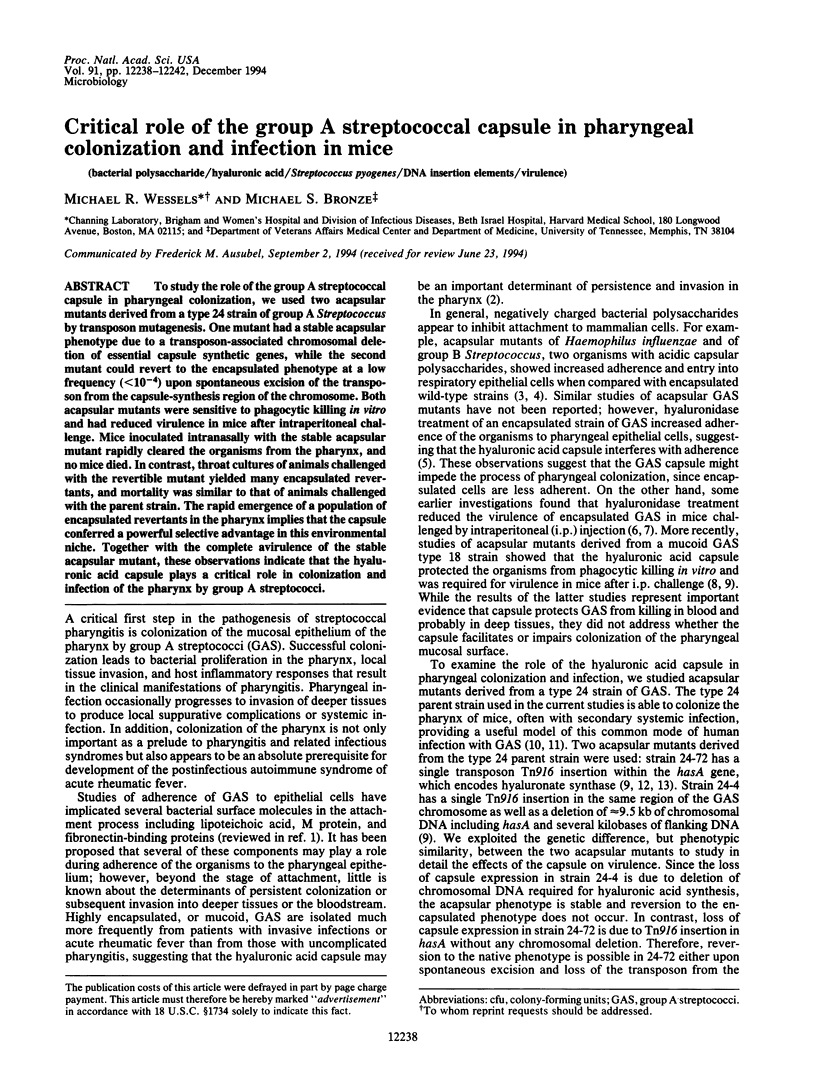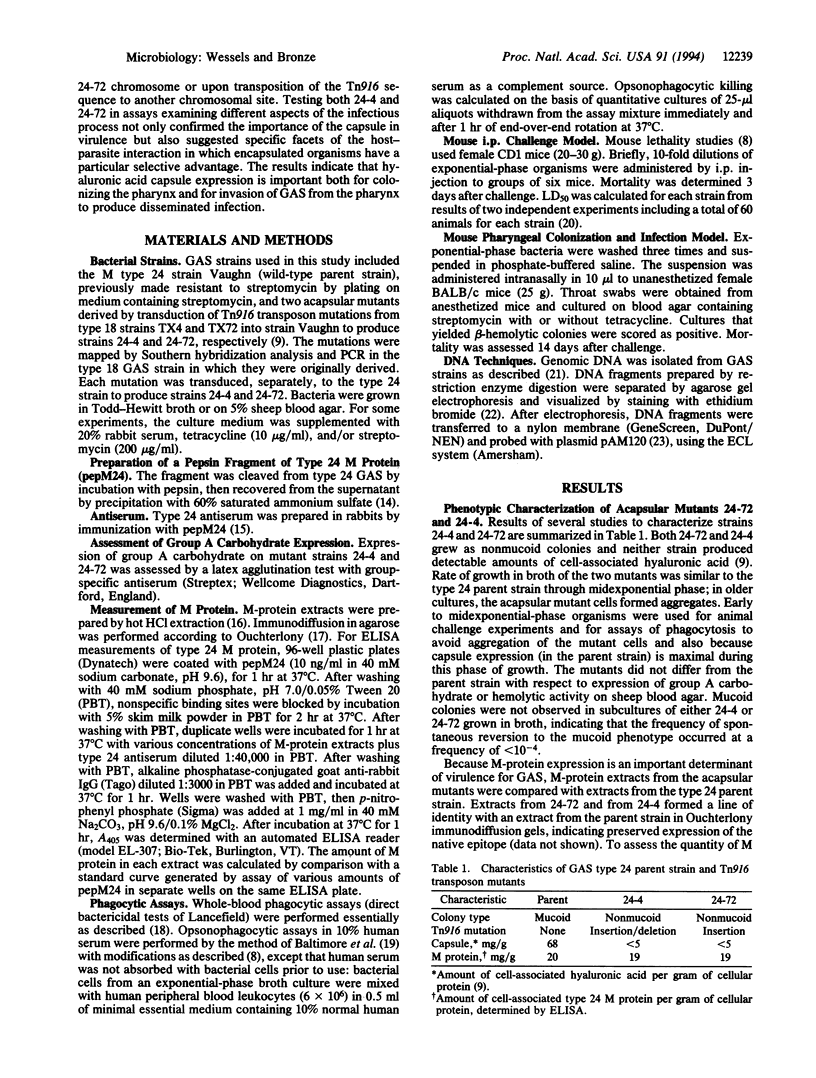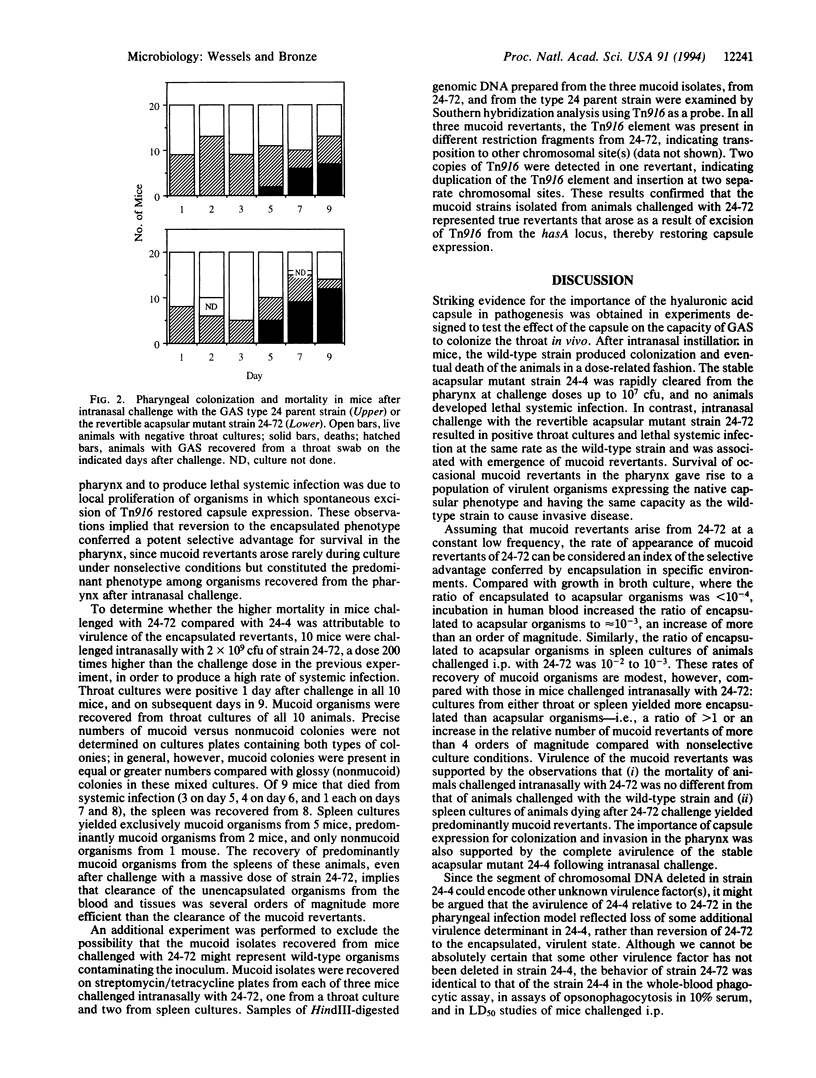Abstract
To study the role of the group A streptococcal capsule in pharyngeal colonization, we used two acapsular mutants derived from a type 24 strain of group A Streptococcus by transposon mutagenesis. One mutant had a stable acapsular phenotype due to a transposon-associated chromosomal deletion of essential capsule synthetic genes, while the second mutant could revert to the encapsulated phenotype at a low frequency (< 10(-4)) upon spontaneous excision of the transposon from the capsule-synthesis region of the chromosome. Both acapsular mutants were sensitive to phagocytic killing in vitro and had reduced virulence in mice after intraperitoneal challenge. Mice inoculated intranasally with the stable acapsular mutant rapidly cleared the organisms from the pharynx, and no mice died. In contrast, throat cultures of animals challenged with the revertible mutant yielded many encapsulated revertants, and mortality was similar to that of animals challenged with the parent strain. The rapid emergence of a population of encapsulated revertants in the pharynx implies that the capsule conferred a powerful selective advantage in this environmental niche. Together with the complete avirulence of the stable acapsular mutant, these observations indicate that the hyaluronic acid capsule plays a critical role in colonization and infection of the pharynx by group A streptococci.
Full text
PDF




Selected References
These references are in PubMed. This may not be the complete list of references from this article.
- Baltimore R. S., Kasper D. L., Baker C. J., Goroff D. K. Antigenic specificity of opsonophagocytic antibodies in rabbit anti-sera to group B streptococci. J Immunol. 1977 Feb;118(2):673–678. [PubMed] [Google Scholar]
- Bartelt M. A., Duncan J. L. Adherence of group A streptococci to human epithelial cells. Infect Immun. 1978 Apr;20(1):200–208. doi: 10.1128/iai.20.1.200-208.1978. [DOI] [PMC free article] [PubMed] [Google Scholar]
- Beachey E. H., Stollerman G. H., Chiang E. Y., Chiang T. M., Seyer J. M., Kang A. H. Purification and properties of M protein extracted from group A streptococci with pepsin: covalent structure of the amino terminal region of type 24 M antigen. J Exp Med. 1977 Jun 1;145(6):1469–1483. doi: 10.1084/jem.145.6.1469. [DOI] [PMC free article] [PubMed] [Google Scholar]
- Bronze M. S., Courtney H. S., Dale J. B. Epitopes of group A streptococcal M protein that evoke cross-protective local immune responses. J Immunol. 1992 Feb 1;148(3):888–893. [PubMed] [Google Scholar]
- Bronze M. S., Dale J. B. Epitopes of streptococcal M proteins that evoke antibodies that cross-react with human brain. J Immunol. 1993 Sep 1;151(5):2820–2828. [PubMed] [Google Scholar]
- Bronze M. S., McKinsey D. S., Beachey E. H., Dale J. B. Protective immunity evoked by locally administered group A streptococcal vaccines in mice. J Immunol. 1988 Oct 15;141(8):2767–2770. [PubMed] [Google Scholar]
- DeAngelis P. L., Papaconstantinou J., Weigel P. H. Isolation of a Streptococcus pyogenes gene locus that directs hyaluronan biosynthesis in acapsular mutants and in heterologous bacteria. J Biol Chem. 1993 Jul 15;268(20):14568–14571. [PubMed] [Google Scholar]
- Dougherty B. A., van de Rijn I. Molecular characterization of a locus required for hyaluronic acid capsule production in group A streptococci. J Exp Med. 1992 May 1;175(5):1291–1299. doi: 10.1084/jem.175.5.1291. [DOI] [PMC free article] [PubMed] [Google Scholar]
- Gawron-Burke C., Clewell D. B. Regeneration of insertionally inactivated streptococcal DNA fragments after excision of transposon Tn916 in Escherichia coli: strategy for targeting and cloning of genes from gram-positive bacteria. J Bacteriol. 1984 Jul;159(1):214–221. doi: 10.1128/jb.159.1.214-221.1984. [DOI] [PMC free article] [PubMed] [Google Scholar]
- Hasty D. L., Ofek I., Courtney H. S., Doyle R. J. Multiple adhesins of streptococci. Infect Immun. 1992 Jun;60(6):2147–2152. doi: 10.1128/iai.60.6.2147-2152.1992. [DOI] [PMC free article] [PubMed] [Google Scholar]
- Hollingshead S. K., Simecka J. W., Michalek S. M. Role of M protein in pharyngeal colonization by group A streptococci in rats. Infect Immun. 1993 Jun;61(6):2277–2283. doi: 10.1128/iai.61.6.2277-2283.1993. [DOI] [PMC free article] [PubMed] [Google Scholar]
- Hulse M. L., Smith S., Chi E. Y., Pham A., Rubens C. E. Effect of type III group B streptococcal capsular polysaccharide on invasion of respiratory epithelial cells. Infect Immun. 1993 Nov;61(11):4835–4841. doi: 10.1128/iai.61.11.4835-4841.1993. [DOI] [PMC free article] [PubMed] [Google Scholar]
- Jacks-Weis J., Kim Y., Cleary P. P. Restricted deposition of C3 on M+ group A streptococci: correlation with resistance to phagocytosis. J Immunol. 1982 Apr;128(4):1897–1902. [PubMed] [Google Scholar]
- James L., McFarland R. B. An epidemic of pharyngitis due to a nonhemolytic group A streptococcus at lowry air force base. N Engl J Med. 1971 Apr 8;284(14):750–752. doi: 10.1056/NEJM197104082841403. [DOI] [PubMed] [Google Scholar]
- Johnson D. R., Stevens D. L., Kaplan E. L. Epidemiologic analysis of group A streptococcal serotypes associated with severe systemic infections, rheumatic fever, or uncomplicated pharyngitis. J Infect Dis. 1992 Aug;166(2):374–382. doi: 10.1093/infdis/166.2.374. [DOI] [PubMed] [Google Scholar]
- LANCEFIELD R. C. Differentiation of group A streptococci with a common R antigen into three serological types, with special reference to the bactericidal test. J Exp Med. 1957 Oct 1;106(4):525–544. doi: 10.1084/jem.106.4.525. [DOI] [PMC free article] [PubMed] [Google Scholar]
- Marcon M. J., Hribar M. M., Hosier D. M., Powell D. A., Brady M. T., Hamoudi A. C., Kaplan E. L. Occurrence of mucoid M-18 Streptococcus pyogenes in a central Ohio pediatric population. J Clin Microbiol. 1988 Aug;26(8):1539–1542. doi: 10.1128/jcm.26.8.1539-1542.1988. [DOI] [PMC free article] [PubMed] [Google Scholar]
- O'Connor S. P., Cleary P. P. In vivo Streptococcus pyogenes C5a peptidase activity: analysis using transposon- and nitrosoguanidine-induced mutants. J Infect Dis. 1987 Sep;156(3):495–504. doi: 10.1093/infdis/156.3.495. [DOI] [PubMed] [Google Scholar]
- OUCHTERLONY O. Diffusion-in-gel methods for immunological analysis. Prog Allergy. 1958;5:1–78. [PubMed] [Google Scholar]
- St Geme J. W., 3rd, Falkow S. Loss of capsule expression by Haemophilus influenzae type b results in enhanced adherence to and invasion of human cells. Infect Immun. 1991 Apr;59(4):1325–1333. doi: 10.1128/iai.59.4.1325-1333.1991. [DOI] [PMC free article] [PubMed] [Google Scholar]
- Wessels M. R., Goldberg J. B., Moses A. E., DiCesare T. J. Effects on virulence of mutations in a locus essential for hyaluronic acid capsule expression in group A streptococci. Infect Immun. 1994 Feb;62(2):433–441. doi: 10.1128/iai.62.2.433-441.1994. [DOI] [PMC free article] [PubMed] [Google Scholar]
- Wessels M. R., Moses A. E., Goldberg J. B., DiCesare T. J. Hyaluronic acid capsule is a virulence factor for mucoid group A streptococci. Proc Natl Acad Sci U S A. 1991 Oct 1;88(19):8317–8321. doi: 10.1073/pnas.88.19.8317. [DOI] [PMC free article] [PubMed] [Google Scholar]
- Whitnack E., Beachey E. H. Antiopsonic activity of fibrinogen bound to M protein on the surface of group A streptococci. J Clin Invest. 1982 Apr;69(4):1042–1045. doi: 10.1172/JCI110508. [DOI] [PMC free article] [PubMed] [Google Scholar]


